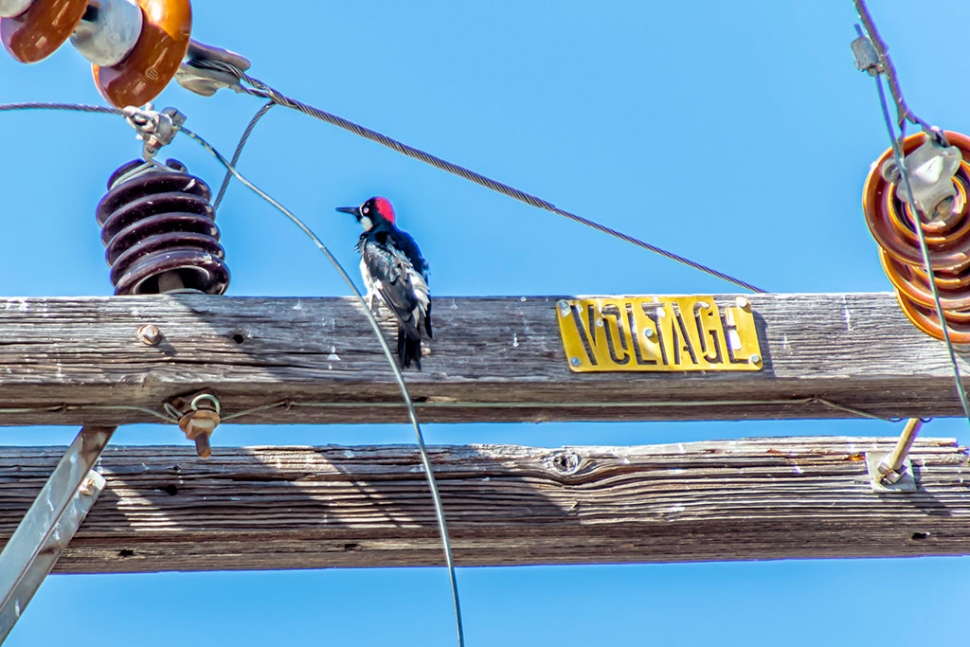|
Focus on Photography
 Photo of the Week "According to Audubon, it’s an acorn woodpecker high up on a power pole perhaps recharging his aero-phone" by Bob Crum. Photo data: Canon 7DMKII camera, manual mode, Tamron 16-300mm lens @300mm. Exposure; ISO 200, aperture f/6.3, shutter speed 1/500 of a second. By Bob Crum — Wednesday, July 31st, 2019
Stuck on Manual
 Bob Crum So many emails I need a secretary. Beginning with Tracy L., who asked: All I ever see in the photo of the week data is the camera was in manual mode. Is that your only camera mode? It delights me enormously that readers like Tracy review the photo of the week data. I'm also impressed. It's true that "manual" mode is cited most often. And Tracy's question is appropriate, considering that there are other semi-automatic and automatic modes to automate photo making. However, I don't always agree with what the camera's computer wants to do in a semi-automatic or auto mode. So, rather than argue with the camera, I simply switch to manual mode and take control. Consider my Ford Ranger pickup as an equivalent example because it has a 5-speed manual transmission. While it's often more convenient to have an automatic transmission, a manual tranny often provides more vehicle control. For example, going down hills, I can downshift to a lower gear and use engine braking, saving my wheel brakes. I can also downshift when climbing mountain roads, keeping the RPMs in the optimum power range. The camera in Auto mode can't know what I want. Manual mode gives me complete control over exposure for the kind of photo I want to make. Remember the exposure triangle I presented a year and a half ago: Aperture, shutter speed and ISO? Sure you do. For example, if I'm shooting a fast-paced subject, bull riders, pelicans diving for fish or mermaids playing water polo, I prefer a relatively fast shutter speed to freeze action. Hence, I set the shutter speed at 1/500th of a second, aperture f/11. Another example, to create a sunstar effect in the photo I'm making I'll stop down the aperture to f/18 or f/22 and increase the shutter speed to compensate for the reduction in light. I usually keep ISO on auto mode, letting it go where the camera determines it needs for proper exposure. If necessary, I'll dial in ISO but that's a subject for another day. So you see, in manual mode, it's important to note that I can create the photo as I desire. It's this creative aspect of photography that I greatly enjoy. But as often happens, camera-determined exposure, though perhaps correct, is not always what I desire. Maybe I want to underexpose slightly to infer a mood. Maybe I prefer to lighten up (high key) a particular image. In other words, suppose that I'm not happy with what the camera determined is the proper exposure. No problem. After a refreshing strawberry margarita, I'll simply adjust 'Exposure Compensation.' A button on my camera is labeled +/-. Push it and it brings up the Exposure Compensation adjustment where I can increase or decrease the exposure depending on my desires. I'll discuss Av, Tv, P and A modes another time. Photo of the week is nothing spectacular. It's just of a cute little acorn woodpecker. Though I'm not a dedicated birder like many photographers, I will take the opportunity to capture an interesting bird photo. This little guy up on the nearby power pole juxtaposed with the sign 'voltage' was irresistible. Yes, Tracy, manual mode! Ahem! There's a deliberate error in the description above regarding Send comments, suggestions or questions to: focusonphotography@earthlink.net |
